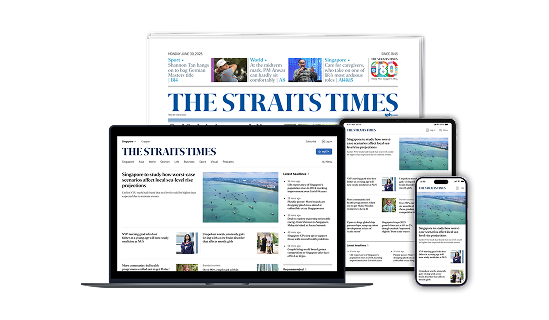Trump tariff hike brings added China rate to 145% as Beijing curbs Hollywood film imports
Sign up now: Get ST's newsletters delivered to your inbox

US President Donald Trump has raised new tariffs on Chinese imports to 125 per cent, on top of a 20 per cent duty from earlier in the year.
PHOTO: EPA-EFE
Follow topic:
WASHINGTON - US President Donald Trump’s steep tariff hike targeting Chinese goods, which took effect on April 10, brings Washington’s additional rate on many products to 145 per cent, the White House confirmed.
China bit back on April 10 by saying it would immediately restrict imports of Hollywood films,
Wall Street stocks tumbled on April 10 on mounting worries over the economic impact of Mr Trump’s multi-front tariff war.
Since returning to the presidency on Jan 20, Mr Trump has imposed waves of tariffs on sectors such as steel and aluminium imports, as well as vehicles.
Most recently, he imposed a baseline 10 per cent tariff on most US trading partners – but on April 9 the President announced a 90-day halt in higher duties
This pause came into effect on April 10 and lifts on July 9, a White House order showed.
But Mr Trump also doubled down by raising new tariffs on Chinese imports to 125 per cent.
The figure stacks atop a 20 per cent additional duty from earlier in 2025 over China’s alleged role in the fentanyl supply chain, which brings the total to 145 per cent, piling on existing levies from past administrations.
But the latest 125 per cent figure on China, aimed at addressing practices Washington has deemed unfair, contains notable exclusions.
It excludes products such as steel and aluminium imports, as well as vehicles, on which Mr Trump has imposed 25 per cent tariffs under separate regimes.
The number does not apply either to goods such as copper, pharmaceuticals, semiconductors, lumber and energy products – some of which are sectors Mr Trump is mulling over future action against.
All of this paints a more complicated picture of tariff levels, even as tensions soar between Washington and Beijing.
Hollywood films
Industry analysts said the financial impact of restricting imports of Hollywood films was likely to be minimal, however, because Hollywood’s box office returns in China have declined significantly in recent years.
After three decades during which China imported 10 Hollywood movies per year, Beijing’s National Film Administration (NFA) said Mr Trump’s tariff actions would further sour domestic demand for US cinema in China.
“We will follow market rules, respect the audience’s choices, and moderately reduce the number of American films imported,” the NFA said on its website.
Small parcels
Mr Trump’s latest order promises further disruptions to imports of popular low-cost imports from China, which can cover clothing and small appliances.
Besides the higher tariff rate on Chinese goods, he also raised the stakes for small packages from the country – increasing the duties they face from 90 per cent to 120 per cent.
These take effect from May 2.
The per item rate is lifted again as well, to US$100 (S$130) from May 2, and US$200 from June 1.
The rules were enacted after Mr Trump signed an order canceling the duty-free exemption for goods from China valued at US$800 or below.
The exemption faced huge scrutiny as US officials pointed to the growth of Chinese-founded online retailers Shein and Temu as a reason behind a surge in such low-value shipments from China.
Wall Street tumbles
All three major US stock indexes suffered steep losses on April 10, forfeiting much of the previous session’s gains as growing concerns over the escalating Washington-Beijing trade face-off dampened optimism over upbeat economic data and US-Europe trade negotiations.
After Mr Trump announced a 90-day tariff reprieve on April 9, the S&P 500 surged 9.5 per cent, the largest one-day percentage jump since October 2008.
The tech-heavy Nasdaq soared 12.2 per cent, notching its second-biggest daily gain on record.
Following the whipsaw of the April 9 bounce and April 10 sell-off, the S&P 500 remained 7.1 per cent below where it was just before the reciprocal tariffs were announced last week. AFP, REUTERS

